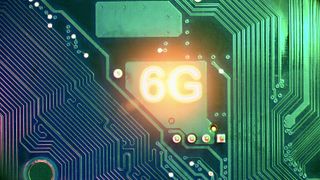MWC 2023: Can AI-embedded 6G 'greenify' next-gen networking?
AI can put us on the path to more sustainable 5.5G and 6G networks, but the technology might itself be too power-guzzling

There’s something frighteningly all-consuming about Mobile World Congress (MWC) that makes it both a fascinating and draining experience. There are eight halls jam-packed with bright lights, spectacle, and unparalleled technological advancements. Each year I come to see it all, and each year I leave having only seen about a third.
This year’s theme was ‘velocity’ accompanied by the tagline ‘unleashing tomorrow’s technology today’. Concepts like the metaverse, artificial intelligence (AI) and 6G were showcased everywhere. But everything was tied together with environmental concerns, with most offerings pitched as a solution to tech's ever-growing carbon footprint.
Embracing green technology
The problem is getting worse. The amount of data businesses generate annually by 2030 will be measured in "yottabytes" according to Huawei’s storage expert Dr Peter Zhou. The term is already available, if not quite yet needed; it's the largest unit recognised by the International System of Units (SI). Data was only ever going in this direction, and we’re already storing so much that it’s harming the planet. This problem hangs over the industry and technologies like the Internet of Things (IoT) and the metaverse, which heavily rely on sensor technology and AI.

Huawei used MWC’s day zero event to present a cohort of green tech initiatives. The head of climate action for GSMA, Steven Moore, spoke about the shelf life of our mobile devices – none of which are anywhere near 100% renewable. He called for manufacturers to push for longer life spans, suggesting even a one-year extension would equate to taking 4.7 million cars off the road. Similarly, Orange’s SVP of operations and network economics, Emmanuel Chatard, urged normalising the use of secondhand equipment in mobile networks.
While that may help to reduce e-waste, we face a more daunting challenge in the form of power consumption – particularly on mobile networks. As many already know, 5G drains a phone’s battery very quickly. Part of this is the phone itself searching for the best signal, but our network signals are also working much harder than they need to.
How 6G networks will utilise AI
6G is expected to massively increase data consumption and speeds with virtually zero latency, according to principal research scientist and co-director at Telefonica Research, Nicolas Kourtellis, speaking on stage at MWC.
There’s a new generation of mobile networking technology roughly every ten years, with 6G slated for approximately 2030. To counter 5G’s deficiencies, however, Huawei is currently looking at something called 5.5G, which is predicted to improve sensing technology and power efficiency. Ultimately, though, it’s the midway point in the journey to 6G, and that’s where things get a little more exciting.
Get the ITPro. daily newsletter
Receive our latest news, industry updates, featured resources and more. Sign up today to receive our FREE report on AI cyber crime & security - newly updated for 2024.
Several elements will make ssmart and superfast 6G a reality, including low latency, AI and advancements in sensor technology. Huawei believes 6G networks will need to be so embedded with AI that they could actually be categorised as AI systems in their own right.

Part of the intelligence will be used to manage beamform signals, which is what transfers data to devices. And, with 6G, the network will be smart enough to moderate that signal, automating it in a way that’s low in latency and more efficient. If Huawei is correct, 6G will be both a technological advancement and a radical solution to the rising carbon footprint of mobile telecoms.
Using technology to work smarter not harder
Using AI to save the planet is a bit counter-intuitive, though, in that AI computation is extremely power-hungry. The idea we can use power more efficiently with one of the greatest culprits behind tech’s massive carbon footprint seems bizarre.
“I think that’s the interesting part,” Carmen Fontana, a member of the Institute of Electrical and Electronics Engineers (IEEE), tells IT Pro. “These processors get smarter and smarter, they can do more, but they’re also big energy consumers.”
Fontana, who is also VP operations at Augment Therapy, ays these same power consumption issues have plagued blockchain.
“We can do all these cool things, but it’s terrible for the environment. So I do think that these chip processors, or the general cloud environment, have to be smarter and make that a priority versus just more and more power,” she continues. “On the flip side, we can use a lot of these connected devices in applications like utility grids to make them smarter about how we use the utility grid. Maybe we’re counteracting the use of the chips, but also it will allow us to be more efficient with our use of the electrical power.”
There is another layer here; not only are these initiatives beneficial to the environment but they can be harnessed to cut costs. Economic woes, which are fuelling the cost of living crisis, are hitting the global economy and supply chains. The tech industry is cutting jobs, and businesses, particularly in the UK, are contending with shrinking budgets. Sustainability aside, as important as it is, we all need technology to help us do more with less, and to work smarter and not harder.
Bobby Hellard is ITPro's Reviews Editor and has worked on CloudPro and ChannelPro since 2018. In his time at ITPro, Bobby has covered stories for all the major technology companies, such as Apple, Microsoft, Amazon and Facebook, and regularly attends industry-leading events such as AWS Re:Invent and Google Cloud Next.
Bobby mainly covers hardware reviews, but you will also recognize him as the face of many of our video reviews of laptops and smartphones.





